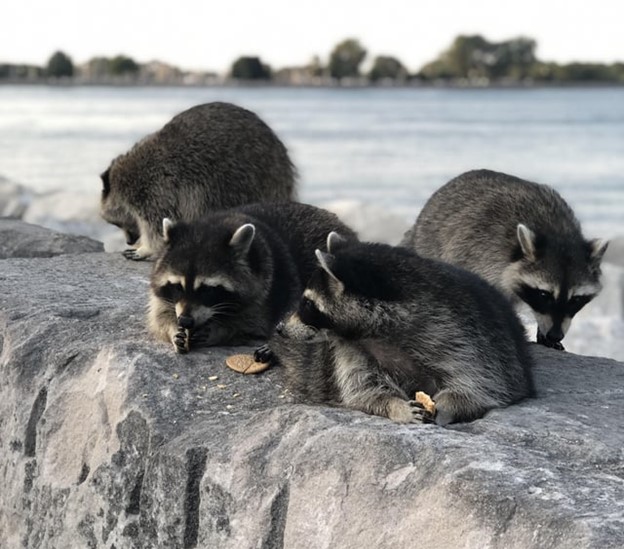by Ron Becker, Class of 2019
On June 2, 2024, the Chicago Tribune published an article describing how the built environment affects the mammal species seen in various Chicago neighborhoods. I expect that several people reacted like I did: Which mammals are being seen? Where? How many? The simple answer- a lot and many!
The largest wild animal that is being seen is the white-tailed deer, the state animal of Illinois. They are seen in cemeteries, golf courses, and forest preserves.

The predator of the deer is the coyote, and there are thousands of coyotes in the Chicago area. One pair is reported to have raised a litter in a den at Soldier Field.

Another wild canine is the red fox. A family of foxes created a media sensation last summer when they made Lurie Garden their home.

People are curious about other large predators. The number of wolf sightings in Illinois has been increasing this century. They are usually lone males who have left their birth pack to seek their own territory. Their source is likely in Wisconsin. Another large predator is the American black bear. Last year a black bear was sighted in Lake County, likely from Wisconsin as well. Wisconsin seems to be sending us more than just brats, beer, and cheese!

There are also large cats. In 2022 there were two confirmed sightings of mountain lions in Illinois. One was killed in an automobile collision in DeKalb, and the other was trapped and relocated near Springfield. Illinois’ only native wildcat is the bobcat. They have been documented in 99 of the state’s 102 counties. Their numbers have been increasing to such an extent that an annual harvest, read hunt, was authorized, beginning in 2016.

While bobcats and other large predators have yet to be seen in Chicago, the possibility seems to be growing. Their likely point of entry will be along rail lines. Since Chicago is “The Railroad Capital of America”, there are many points of egress. Another avenue of dispersal is the lake and area waterways. This could be how the beavers that called Northwestern University home, before they were suspiciously found dead, came here. I have seen the damage that beavers did to trees in the Jackson Park lagoons before they were trapped and relocated.
Other mammals found in riparian habitats are the common muskrat and American mink. They have been seen in the Skokie Lagoons and are likely in other waterways. Another water-loving mammal is the river otter. They were seen in Cook County in 2015 after a long absence. Primarily seen in the south suburbs of South Holland, Palos and Lemont, there was also a sighting from Barrington. River otters are an indicator-species that require clean water. As we improve the quality of our waterways, we could hopefully see them frolicking in the Chicago River someday.

An ubiquitous group found around Chicago is the tree squirrel. Of the four species found in Illinois, the two most common are the fox squirrel and its slightly smaller cousin, the eastern gray squirrel. The other two, the southern flying squirrel and the red squirrel (that is making a comeback in Illinois), are rarely seen in the city.
Illinois also has four species of ground squirrels. The eastern chipmunk is the most frequently seen, while the thirteen-lined ground squirrel and the groundhog or woodchuck are also common. To see the fourth species, Franklin’s ground squirrel, go to Kane County or southern Illinois. Other furry critters are the eastern cottontail, the Norway rat (a big problem), the field mouse, and voles. I once saw a vole, either a prairie vole or meadow vole, running between beds in Lurie Garden.
Another species common to Chicago, especially along the lakefront, is the northern raccoon.

Other species, numbering in the thousands, are bats. They are rarely seen unless you go looking for them at night or they live in your building. The seven species are the big brown bat, the little brown bat, the silver-haired bat, the eastern red bat, the hoary bat, the evening bat, and the tri-colored bat.
The remaining two species reported are the Virginia opossum, North America’s only marsupial, and the striped skunk. Private companies with wildlife removal permits were reported to have removed more than 14,000 skunks from the Chicago area in 2017.

These animals are out there, so go out and look for them. The Chicago Park District encompasses more than 8,800 acres in more than 600 parks. These include 10 bird and wildlife gardens and 16 lagoons. The Cook County forest preserves have more than 51 square miles of habitat, some within the city. There is also the lakefront and our waterways; the latest addition to which is the Wild Mile in the North Branch Channel. And maybe your own backyard is a sighting place.
________________________________________________________________________________________________________________________________________________________________
 CLICK HERE for more stories on The Bridge.
CLICK HERE for more stories on The Bridge.






Ron, thanks for the comprehensive summary!. I have seen coyotes and foxes in our area. People do not realize how dangerous a fox, particularly a mother, can be. Our neighborhood squirrels are quite brash and will run up to you if you have food. There is a reason it is best not to feed wildlife. Love the photo! Liz
Thanks for the great survey of urban critters. Another good sign of clean water is seeing or hearing frogs–they won’t live in dirty water.
Thanks, Ron. I know that beavers were doing terrible things to the trees in the Japanese garden in Jackson Park. The Park District put fencing around the trees to prevent further damage. But now I think the beavers have been relocated and the entire garden has been restored. Thanks for the look at wildlife we may or may not encounter.
Thanks for the nice story, Ron!